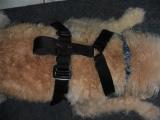-
Posts
3,162 -
Joined
-
Last visited
Posts posted by Baby Dragon
-
-
Mrs TS we got one of those trampoline beds from Big W and it's still fine after 2 1/2 years. I think it was about $60.
-
The mozzies here are shocking at the moment!!!!
Does dog friendly insect repellent exist, and if so, can anyone recommend a good brand?
They are already on Frontline every 2 weeks (instead of every month to help protect them from paralysis ticks) and I put a Companions Choice flea and tick rinse on them every week. But the mozzies still get to them, just now there were about 10 on them!! They are around during the day and night.
I'm worried about overloading them with insect repellents but I want to protect them against the mozzies somehow.
What would be the best thing to use?
Thanks

-
Thank you
 I'll see about feeding less chicken and replace it with a different meat.
I'll see about feeding less chicken and replace it with a different meat. -
Was it from The Barf Shop? http://www.thebarfshop.com.au
-
I tried to find the other raw feeders thread but I couldn't find it

I would like some advice about my dogs diet if possible

I think I'm pretty happy with it, but I'd like some confirmation that they're getting everything they need?
Or any suggestions about how to improve it?
They are a Lab and Lab X.
Monday – Vet’s All Natural Complete Mix and raw chicken. 1/2 dose of joint guard.
Tuesday – Vet’s All Natural Complete Mix and raw chicken. 1/2 dose of joint guard.
Wednesday – Vet’s All Natural Complete Mix and raw chicken. 1/2 dose of joint guard.
Thursday – Vet’s All Natural Complete Mix and raw chicken. 1/2 dose of joint guard.
Friday – Vet’s All Natural Complete Mix and 1 can of mackerel in natural oil (including the oil.) 1/2 dose of joint guard.
Saturday – Vet’s All Natural Complete Mix and raw chicken. 1/2 dose of joint guard.
Sunday – Vet’s All Natural Complete Mix and raw liver or offal (alternating week to week.) 1/2 dose of joint guard
The Lab also gets a fish oil capsule twice a week (the Lab X refuses to have them so I don't force him.)
The raw chicken is normally 1 thigh, 2 or 3 large wings or two drumsticks per night.
Occasionally they will get a section of roo tail instead of raw chicken.
They are both at weights I'm happy with.
Comments or advice would be appreciated.

-
In our old house we chose between floor boards and tiles too. I preferred the look of floor boards, but chose tiles. The main reasons were the possiblity of dog nails scratching the floor boards, and I was told that you can't use chemical cleaners on floor boards because it ruins the varnish.
We went with tiles, but if you're going to choose tiles make sure you get ones with a finish that you're less likely to slip on! The tiles in our old house were quite slippery so we ended up putting mats down which was similar to having carpet, which is what we wanted to avoid! There's also a coating you can have put on the tiles that is supposed to make them less slippery, but we didn't try it so I don't know how good it is.
-
deelee if you're unsure, I'd take her to the vet to be weighed and get their opinion. Then at least you can respond to people that actually the vet says she's in the ideal weight range (assuming she is!)
I'm a relatively new Lab owner and I've been very careful not to let her get overweight. She gets weighed every couple of months to be sure. She's a small girl and people make comments that she must still be a lanky puppy, just because they're used to seeing labs that are so overweight. I love it when I see Goldens and Labs at the correct weight - unfortunately it's not that often!
-
Update:
Action on vicious dog 'vital' after Hastings attackGUIDE Dogs Victoria has urged the State Government to take action on dangerous dogs as a Cranbourne vision-impaired man continues to fight for his life in hospital.
The organisation has called for action against owners of high-risk breeds who allow their animals to go unrestrained in the streets.
On January 20, David Correa was seriously injured when he fell from Hastings pier after a dog attacked his guide dog.
Mr Correa, 34, suffered a fractured spine, broken ribs and a broken collar bone when he plunged into the shallow water on the mud flats below.
The guide dogs organisation has also called on dog owners to keep their animals on a leash and control them so they can’t approach working guide dogs.
Guide Dog Services manager Stewart Blair said he had received complaints from vision-impaired clients whose guide dogs had been attacked by unrestrained dogs.
“Not only are unrestrained dogs a danger to the community but to the vision-impaired person with a guide dog. An attack of this nature robs them of their confidence and independence,” Mr Blair said.
“Even if you perceive your dog is gentle and would not attack, it could still distract a guide dog and endanger a vision-impaired person’s safety.”
The organisation said it had to retire many guide dogs because dog attacks had caused irreparable damage to their working ability.
Mr Correa was taken to Frankston Hospital before being transferred to the Alfred Hospital.
His condition deteriorated last weekend and he was moved into the hospital’s intensive care unit.
The woman whose dog attacked Mr Correa’s dog, Kel, has not yet been found.
http://cranbourne-leader.whereilive.com.au...k-action-vital/
-
I'd love to read any information others have about car safety for dogs or if they know of different brands of safety tested dog seatbelts

If you own a safety tested dog seatbelt maybe you could post a description or review of it, or some photos

-
-
-
I've posted bits and pieces in other threads, but I thought it might be helpful to have all the info on dog seatbelts in one place.
This is a subject I feel very strongly about. When I first got my dog, I didn't really think about safety in the car because as a newbie dog owner nobody really gave me the information I needed, and I didn't see it as a priority. I used to travel around with my dog loose in the back seat, or sometimes I'd tether him in the back seat via collar and leash. Then I moved on to a car harness 'seatbelt' that wasn't safety tested.
Finally, after talking to other dog owners, I wised up and learned that many harness 'seatbelts' are really just tether harnesses - they wouldn't protect your dog like a seatbelt would. They're useful for keeping the dog on the back seat but they aren't really proper seatbelts.
There are two brands of dog seatbelts that I know of that are safety tested. They are the PetBuckle and the Ruff Rider Roadie.
The Ruff Rider Roadie website says that their seatbelts are independently tested to human seatbelt standards http://www.ruffrider.com/about.html
and the PetBuckle website says that their seatbelts are also tested http://www.immioutdoors.com/petbuckle/why_petbuckle.htm
Video of a PetBuckle safety test http://www.youtube.com/watch?v=Ts4sMQA4zqA
Both of these brands come in different designs, and I've tried two of each of their different designs.
This is my experience (with a Lab and a Lab X):
Roadie Elite
Pros: It sits nice and snug on the dog, and it seems like a dog would have a hard time getting out of one on it's own (though I've heard of dogs that have!) It's straight forward and doesn't need adjusting to put it on the dog (it's non adjustable.)
Cons: It's a bit hard to put on the dog, and you have to lift the dog's legs up pretty high to put them through the loops. I personally wouldn't use it on a dog with any joint problems. I also found that my dogs needed one size bigger than it indicated on the sizing guidelines, but that probably depends on the build of dog. The loop where the seatbelt threads through is small and it can be a little bit difficult to get the seatbelt through it. The harness is non adjustable.
Roadie Basic
Pros: I found it easier to put on the dog than the Roadie Elite in that the loops opened up bigger so I didn't have to lift the dog's legs up quite as high. I still wouldn't want to use it on a dog with joint problems. The loop where the seatbelt goes in is bigger than the one on the Roadie Elite so it's easier to put the seatbelt through it.
Cons: There are 3 clips to do up when putting it on the dog and it can be a bit tricky to get the hang of putting it on the dog at first, but easier as you get used to it. It doesn't sit as snugly on the dog as the Roadie Elite and it's a little more bulky.
Here's a video that shows the Roadie Elite and Basic
PetBuckle with silver sliders
Pros: This harness is very easy to put on and take off the dog. The harness is very adjustable, and you can open the loops right up so you don't have to lift the dog's legs up as high as the Roadies to put them through the loops.
Cons: It doesn't seem to sit quite as nicely on my dogs compared to the Roadies. The loop that sits on the dog's chest and goes around the front legs sits a little further forward than what I would like (more on the dog's armpit/leg than the chest.) The harness doesn't go as far down the back of the dog as the Roadies. The harness tends to slide sideways (but that might be because I didn't do it up tight enough?) and unless you have a dog that willingly does a 'down' in the car, it would be difficult to thread the seat belt through the top loop unless you have the PetBuckle teather or unless you have a small dog. You have to re-adjust this harness every time you put it on the dog (although it's very easy to do.)
PetBuckle with red clips
Pros: I found this to be the easiest to put on and take off the dog. You don't have to put the dog's legs through any loops, so I would recommend this harness as the best if your dog has joint issues. You don't have to keep re-adjusting the harness each time you put it on and take it off the dog.
Cons: About the same as above 'PetBuckle with silver sliders.' One difference is that so far I haven't found this harness to slide sideways as much as the PetBuckle with silver sliders, (but that may just be an adjustment thing.)
I like all of the seatbelts for different reasons.
Note that the size and build of your dog will have a great impact on how well a seatbelt fits.
Where to buy?
Waggle has the PetBuckle
ebay has PetBuckles and Roadies from time to time
-
Now that I've tried two different sorts of Pet Buckles and two different sorts of Roadies, I really like all of them for different reasons.
In my experience (with a Lab and a Lab X):
Roadie Elite
Pros: It sits nice and snug on the dog, and it seems like a dog would have a hard time getting out of one on it's own (though I've heard of dogs that have!) It's straight forward and doesn't need adjusting to put it on the dog (it's non adjustable.)
Cons: It's a bit hard to put on the dog, and you have to lift the dog's legs up pretty high to put them through the loops. I personally wouldn't use it on a dog with any joint problems. I also found that my dogs needed one size bigger than it indicated on the sizing guidelines, but that probably depends on the build of dog. The loop where the seat belt threads through is small and it can be a little bit difficult to get the seat belt through it. The harness is non adjustable.
Roadie Basic
Pros: I found it easier to put on the dog than the Roadie Elite in that the loops opened up bigger so I didn't have to lift the dog's legs up quite as high. I still wouldn't want to use it on a dog with joint problems. The loop where the seat belt goes in is bigger than the one on the Roadie Elite so it's easier to put the seat belt through it.
Cons: There are 3 clips to do up when putting it on the dog and it can be a bit tricky to get the hang of putting it on the dog at first, but easier as you get used to it. It doesn't sit as snugly on the dog as the Roadie Elite and it's a little more bulky.
Pet Buckle with silver sliders
Pros: This harness is very easy to put on and take off the dog. The harness is very adjustable, and you can open the loops right up so you don't have to lift the dog's legs up as high as the Roadies to put them through the loops.
Cons: It doesn't seem to sit quite as nicely on my dogs compared to the Roadies. The loop that sits on the dog's chest and goes around the front legs sits a little further forward than what I would like (more on the dog's armpit/leg than the chest.) The harness doesn't go as far down the back of the dog as the Roadies. The harness tends to slide sideways (but that might be because I didn't do it up tight enough?) and unless you have a dog that willingly does a 'down' in the car, it would be difficult to thread the seat belt through the top loop unless you have the Pet Buckle teather. You have to re-adjust this harness every time you put it on the dog (although it's very easy to do.)
Pet Buckle with red clips
Pros: I found this to be the easiest to put on and take off the dog. You don't have to put the dog's legs through any loops, so I would recommend this harness as the best if your dog has joint issues. You don't have to keep re-adjusting the harness each time you put it on and take it off the dog.
Cons: About the same as above 'Pet Buckle with silver sliders.' One difference is that so far I haven't found this harness to slide sideways as much as the Pet Buckle with silver sliders, (but that may just be an adjustment thing.)
I like them all for different reasons, and I hope this helps others who are looking for the right kind of seat belt harness for their dogs.

If anyone wants pictures of the different harnesses on dogs let me know.
-
I recently got two different designs of Pet Buckle harnesses to try. One has silver slider things to adjust the harness. You lift the dog's legs through the loops and tighten the harness to the right size. Then to take the harness off, you loosen it with the sliders.
The other design has two clips similar to seat belt clips. You thread the harness through the dog's legs and then clip it up. You don't have to lift the dog's legs through any loops and once you adjust the harness to the right size, you don't have to keep re-adjusting it. I like both designs but I prefer this design.
-
I own a Lab and I still have trouble telling Labs and Goldies apart
 Usually I look at the tail and that gives it away.
Usually I look at the tail and that gives it away.Great clip!!!! What a clever pup

-
The collars on your website are gorgeous

-
This sounds more like it is a companion dog (for help at home, not in public places.)
Little Jordan's new best friend21 Jan, 2010 09:58 AM
WANDA, a quirky black Labrador, has quickly settled into her new role as best friend for Albany muscular dystrophy sufferer, three-year-old Jordan Rogers.
Wanda is the first assistance dog in Albany and lends Jordan a helping paw.
The dog has already begun to change Jordan’s life by giving her the freedom to be more independent.
Provided by Assistance Dog Australia, Wanda was welcomed into the Rogers’ family as Jordan’s companion dog late last year.
Wanda is there to pick up toys Jordan drops, help Jordan open doors and provide loving friendship.
Jordan’s mother Natalie said Wanda had been fantastic.
“She gives Jordan more independence because when she’s playing or drops things, Wanda is there to help her,” she said.
“She will provide more freedom for Jordan with many things we take for granted like turning on light switches.
“And having a dog is just so exciting and fun for the whole family. Wanda makes life so much better.”
As a companion dog, Wanda is trained to provide Jordan with physical and emotional therapy that will allow her to achieve age-appropriate independence.
Assistance Dogs Australia trains Labradors and golden retrievers to give freedom and independence to people with disabilities.
Each dog is an investment of over $25,000 but is placed free of charge.
http://albany.yourguide.com.au/news/local/...nd/1730884.aspx
-
Anita, Mika, inseparable
PEOPLE are reminded that assistance dogs for people with disabilities are allowed in shopping centres and other public places.
Rockingham resident Anita Gustafsson has at times met with rude and inappropriate comments while shopping in Rockingham and says many people did not know that assistance dogs can go anywhere except in an operating theatre or a commercial kitchen in the course of their duties.
Anita’s assistance dog is a miniature pincher named Mika and is one of 70 assistance dogs across Australia whose owners suffer from complications with diabetes – Anita has had Type 1 since she was eight months old.
She was having 12 injections a day until six years ago when she began using an insulin pump, but she then developed a complication where she could not detect if her sugar levels were up or down – until Mika came along.
Anita calls Mika her life saver.
Anita first left a shirt she had worn when her sugar levels were low with Mika until the dog became familiar with the smell.
Since the pair have been together Anita said she had not had a coma or a seizure at all, something she had lived in fear of. Mika bites Anita gently on her hands and feet if her sugar levels are too low.
The little dog even nuzzles and wakes her in the morning if it sniffs out a problem.
The group Paws for Diabetes has run the assistance dog program for a couple of years now. Mika wears a little “uniform” with a badge on it and people are asked not to pat her as she is “working” and must be left alone to do so.
http://weekend.inmycommunity.com.au/news-a...arable/7545155/
-
Assistance dogs to access all areas
RACHEL TOUNE
January 21st, 2010
A TOWNSVILLE woman with a seizure alert dog said she was refused entry to a restaurant and embarrassed at a cinema.
Alison Brennan and Adonis, the first detection dog of its kind in the city, were turned away from Satay Mas and had to convince Warrina Cineplex to allow her in.
The Kelso resident and her labrador have been together since 2003, with the canine companion alerting her to oncoming epileptic fits.
The two have rarely had problems with Townsville businesses and after recent changes to legislation, can not be denied entry.
Mrs Brennan, however, said Satay Mas would not allow her assistance dog inside and their position on the ban had not changed, despite her explanations.
''They need to know guide dogs and assistance dogs are exempt from the hygiene rules, except they aren't allowed to go in the kitchen,'' she said.
''Every now and again I'll ring up to make a booking and say 'I've got an assistance dog' to see if their situation's changed, but it hasn't.''
Satay Mas owner Patrick Chong said he was unaware of changes in health department regulations.
''If the health department is saying they're allowed, I won't mind ... we are happy to serve her if they have the authority from the health department,'' he said.
''It's just because of hygiene ... it's not a shopping centre, it's a restaurant.
''We don't mind serving her - we are happy to serve anybody.''
Mrs Brennan said she would prefer to walk out of businesses if refused entry rather than become involved in what was often lengthy and embarrassing conversations.
''If somebody says no, I'd just rather go somewhere else rather than have them hovering and waiting for him to do something wrong,'' she said.
The laws governing assistance dogs were tightened in July with the State Government announcing businesses faced a $50,000 fine for discriminating against people who rely on the animals.
Mrs Brennan said Warrina Cineplex backed down and allowed her entry to watch a film following a lengthy debate.
''You've got people lined up to buy tickets and everyone can hear the whole conversation,'' she said.
''That was really awkward, having to say what he does for me in front of all those people.''
The manager of the cinema refused to comment on the incident.
Mrs Brennan said she believed some businesses were oblivious to the new laws.
''I don't think anybody really knows that they can be fined by it,'' she said.
''I'm happy around Townsville to the point where I'm taken aback if I get refused entry or made to feel uncomfortable,'' he said.
''There's restaurants in town who ask if I want to order anything for Adonis ... it's so nice.''
Mrs Brennan said she wanted to raise awareness about the assistance dogs, especially for 'invisible' disabilities.
''If I'm somewhere and someone asks me what he's for I explain about what assistance dogs do and things like that because the next person that gets pulled up might not be as comfortable discussing their issues.''
Adonis can predict seizures up to 15 minutes before one occurs, as well as roll Mrs Brennan into the recovery position and find help if she has been in the seizure for longer than usual.
The assistance dog also growls when he sees flickering fluorescent lights, knowing it is one of his master's triggers.
Disability Services MP Annastacia Palaszczuk encouraged all businesses to abide by the spirit of the new laws.
''They're about protecting vulnerable Queenslanders and ensuring people with a disability can access public places.''
http://www.townsvillebulletin.com.au/artic..._newsphoto.html
-
I don't know anything about RP, but with the organisation I'm with I know that these are some of the things they do and the costs:
Evaluating pup, purchasing pup, vaccinations, desexing, regular vet checks (sometimes x-rays), feeding, collars, leashes, bowls, vests, bedding, crates, training tools, building and grounds maintanance, uniforms, ID cards, fuel costs to travel to different places to train the dogs, insurance, phone calls, internet costs, computer, electricity, bathing and grooming. They also sit on state committees and things and have to travel there, pay for accommodation etc. Raising and training the pups until they are around 16 - 24 months old.
They give support to recipients for the lifetime of the dog either in person, via phone or email. They do testing and team training with every recipient. I was also surprised at how many vet checks and clearances and things my dog had had by the time I got her because they gave me her full vet history.
And I'm sure there's a lot more, but they are just some of the things I've seen.
-
Some organisations charge, some have the recipient agree to fundraise a certain amount, and some give the dog to the recipient for free. I suppose it all depends on how the organisation is run, how many staff they have, if they're paid staff or volunteers, how much the dogs they get cost or if they're donated, etc.
I was fortunate enough to be given my assistance dog for free. But that still means that somebody had to pay for it somewhere. My organisation spends time doing a lot of fundraising, they have businesses that sponsor them and all the staff are volunteers.
-
I'm glad you found something that's working for you SecretKei :D
-
Ok, I have a Roadie Elite, Roadie Basic and Pet Buckle for each dog. I can't decide which I like best out of the Roadie Basic and the Pet Buckle.
-
It doesn't say where the dog will be coming from, but at a guess it could be from http://righteouspups.org.au/









Dog Friendly Insect Repellent?
in Health / Nutrition / Grooming
Posted
Thank you everyone, there are a few options there I can look into